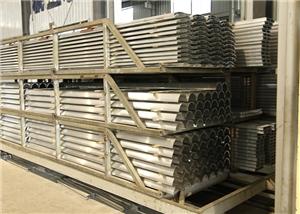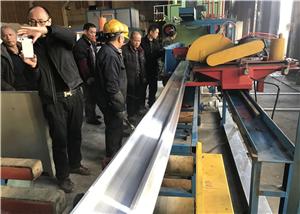What is aluminum extrusion machine?
Aluminum extrusion machine is a kind of industrial equipment specially used to heat aluminum alloy materials and extrude them through dies. The core of the extruder is to use high temperature and high pressure to plastically deform aluminum materials through molds to form products with specific cross-sectional shapes, such as pipes, rods, plates, and profiles. These extruded aluminum profiles are widely used in building structures, vehicles, electronic components and other industrial fields.
Working process of aluminum extrusion press
The working process of the aluminum extrusion machine can be divided into the following steps:
1. Raw material preparation
The first step in the aluminum extrusion process is the preparation of raw materials. Usually, aluminum extrusion machines use aluminum ingots or aluminum rods as raw materials. These aluminum alloy materials require careful inspection and preparation before extrusion to ensure that their quality meets requirements. Typically, these raw materials are preheated to reduce the energy required during the extrusion process and improve the quality of the extruded product.
2. Preheating process
Before extrusion, the aluminum ingot or rod needs to be heated to a certain temperature, usually between 450°C and 500°C. This heating process is called preheating, and its purpose is to make the aluminum material have good plasticity and fluidity, so that it can pass through the mold smoothly during extrusion and form the required cross-sectional shape.
3. Loading
The preheated aluminum ingot is placed into the extrusion barrel. The extrusion barrel is a cylindrical container that holds the aluminum ingot and pushes it forward through the extrusion rod. After the aluminum ingot enters the extrusion barrel, it is ready to enter the next step of the extrusion process.
4. Extrusion process
The extrusion process is the core part of the aluminum extrusion machine. Through a hydraulic system, the extrusion rod pushes the aluminum ingot through the extrusion die under high pressure. The cross-sectional shape of the mold determines the cross-sectional shape of the extruded finished product. As the aluminum ingot passes through the mold under high temperature and pressure, the material is shaped to form a continuous aluminum profile. This process can produce a variety of complex cross-sectional shapes, such as square, round, grooved, etc.
5. Cool down
Extruded aluminum profiles remain soft at high temperatures and require a cooling process to harden and keep their shape stable. Usually, the cooling process is carried out by air cooling or water cooling. The rate and method of cooling affects the mechanical properties of the final product and therefore needs to be adjusted to specific product requirements.
6. Stretching and straightening
In order to eliminate the internal stress generated during the extrusion process, aluminum profiles usually undergo a stretching and straightening process. Through this process, the dimensional accuracy and surface quality of aluminum profiles are improved. Stretch straightening can make the product flatter and improve its mechanical properties.
7. Cutting
After stretching and straightening, the extruded aluminum profiles are usually cut to the required length. Cutting can be adjusted according to the customer's specific requirements, ensuring that the dimensions of the finished product meet the standards. This step is also to facilitate subsequent processing or to be used directly to manufacture finished products.
8. Aging treatment
For some aluminum profiles that require specific mechanical properties, aging treatment is the final step. Aging treatment improves the hardness and strength of aluminum profiles by keeping them at a certain temperature for a certain period of time. This treatment process is essential to increase the durability and longevity of the material.




